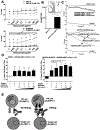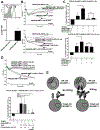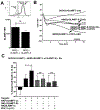Enhanced SLAMF7 Homotypic Interactions by Elotuzumab Improves NK Cell Killing of Multiple Myeloma
- PMID: 31431433
- PMCID: PMC6774869
- DOI: 10.1158/2326-6066.CIR-18-0579
Enhanced SLAMF7 Homotypic Interactions by Elotuzumab Improves NK Cell Killing of Multiple Myeloma
Abstract
Elotuzumab (Elo) is an IgG1 monoclonal antibody targeting SLAMF7 (CS1, CRACC, and CD319), which is highly expressed on multiple myeloma (MM) cells, natural killer (NK) cells, and subsets of other leukocytes. By engaging with FcγRIIIA (CD16), Elo promotes potent NK cell-mediated antibody-dependent cellular cytotoxicity (ADCC) and macrophage-mediated antibody-dependent cellular phagocytosis (ADCP) toward SLAMF7+ MM tumor cells. Relapsed/refractory MM patients treated with the combination of Elo, lenalidomide, and dexamethasone have improved progression-free survival. We previously showed that Elo enhances NK cell activity via a costimulation mechanism, independent of CD16 binding. Here, we further studied the effect of Elo on cytotoxicity of CD16-negative NK-92 cells. Elo, but not other SLAMF7 antibodies, uniquely enhanced cytotoxicity mediated by CD16-negative NK-92 cells toward SLAMF7+ target cells. Furthermore, this CD16-independent enhancement of cytotoxicity required expression of SLAMF7 containing the full cytoplasmic domain in the NK cells, implicating costimulatory signaling. The CD16-independent costimulation by Elo was associated with increased expression of NKG2D, ICAM-1, and activated LFA-1 on NK cells, and enhanced cytotoxicity was partially reduced by NKG2D blocking antibodies. In addition, an Fc mutant form of Elo that cannot bind CD16 promoted cytotoxicity of SLAMF7+ target cells by NK cells from most healthy donors, especially if previously cultured in IL2. We conclude that in addition to promoting NK cell-mediated ADCC (CD16-dependent) responses, Elo promoted SLAMF7-SLAMF7 interactions in a CD16-independent manner to enhance NK cytotoxicity toward MM cells.
©2019 American Association for Cancer Research.
Conflict of interest statement
Figures







Similar articles
-
Mechanisms of NK Cell Activation and Clinical Activity of the Therapeutic SLAMF7 Antibody, Elotuzumab in Multiple Myeloma.Front Immunol. 2018 Nov 5;9:2551. doi: 10.3389/fimmu.2018.02551. eCollection 2018. Front Immunol. 2018. PMID: 30455698 Free PMC article. Review.
-
Elotuzumab, a potential therapeutic humanized anti-SLAMF7 monoclonal antibody, enhances natural killer cell-mediated killing of primary effusion lymphoma cells.Cancer Immunol Immunother. 2022 Oct;71(10):2497-2509. doi: 10.1007/s00262-022-03177-6. Epub 2022 Mar 9. Cancer Immunol Immunother. 2022. PMID: 35262781 Free PMC article.
-
The anti-SLAMF7 antibody elotuzumab mediates NK cell activation through both CD16-dependent and -independent mechanisms.Oncoimmunology. 2017 Jun 16;6(9):e1339853. doi: 10.1080/2162402X.2017.1339853. eCollection 2017. Oncoimmunology. 2017. PMID: 28932638 Free PMC article.
-
Elotuzumab Enhances CD16-Independent NK Cell-Mediated Cytotoxicity against Myeloma Cells by Upregulating Several NK Cell-Enhancing Genes.J Immunol Res. 2024 Feb 27;2024:1429879. doi: 10.1155/2024/1429879. eCollection 2024. J Immunol Res. 2024. PMID: 38444839 Free PMC article.
-
Update on elotuzumab, a novel anti-SLAMF7 monoclonal antibody for the treatment of multiple myeloma.Expert Opin Biol Ther. 2016 Oct;16(10):1291-301. doi: 10.1080/14712598.2016.1221920. Epub 2016 Aug 17. Expert Opin Biol Ther. 2016. PMID: 27533882 Review.
Cited by
-
Blocking the PCNA/NKp44 Checkpoint to Stimulate NK Cell Responses to Multiple Myeloma.Int J Mol Sci. 2022 Apr 25;23(9):4717. doi: 10.3390/ijms23094717. Int J Mol Sci. 2022. PMID: 35563109 Free PMC article.
-
The FcγRIIIA (CD16) L48-H/R Polymorphism Enhances NK Cell-Mediated Antibody-Dependent Cellular Cytotoxicity by Promoting Serial Killing.Cancer Immunol Res. 2025 Mar 4;13(3):417-429. doi: 10.1158/2326-6066.CIR-24-0384. Cancer Immunol Res. 2025. PMID: 39666369
-
Immunological conversion of solid tumours using a bispecific nanobioconjugate for cancer immunotherapy.Nat Nanotechnol. 2022 Dec;17(12):1332-1341. doi: 10.1038/s41565-022-01245-7. Epub 2022 Nov 10. Nat Nanotechnol. 2022. PMID: 36357792 Free PMC article.
-
The Role of Monoclonal Antibodies in the Era of Bi-Specifics Antibodies and CAR T Cell Therapy in Multiple Myeloma.Cancers (Basel). 2021 Sep 29;13(19):4909. doi: 10.3390/cancers13194909. Cancers (Basel). 2021. PMID: 34638393 Free PMC article. Review.
-
SLAM Modification as an Immune-Modulatory Therapeutic Approach in Cancer.Cancers (Basel). 2023 Sep 29;15(19):4808. doi: 10.3390/cancers15194808. Cancers (Basel). 2023. PMID: 37835502 Free PMC article. Review.
References
-
- Rajkumar SV, Blood E, Vesole D, Fonseca R, Greipp PR, Eastern Cooperative Oncology G. Phase III clinical trial of thalidomide plus dexamethasone compared with dexamethasone alone in newly diagnosed multiple myeloma: a clinical trial coordinated by the Eastern Cooperative Oncology Group. Journal of clinical oncology : official journal of the American Society of Clinical Oncology 2006;24(3):431–6 doi 10.1200/JCO.2005.03.0221. - DOI - PubMed
Publication types
MeSH terms
Substances
Grants and funding
LinkOut - more resources
Full Text Sources
Other Literature Sources
Medical
Miscellaneous

